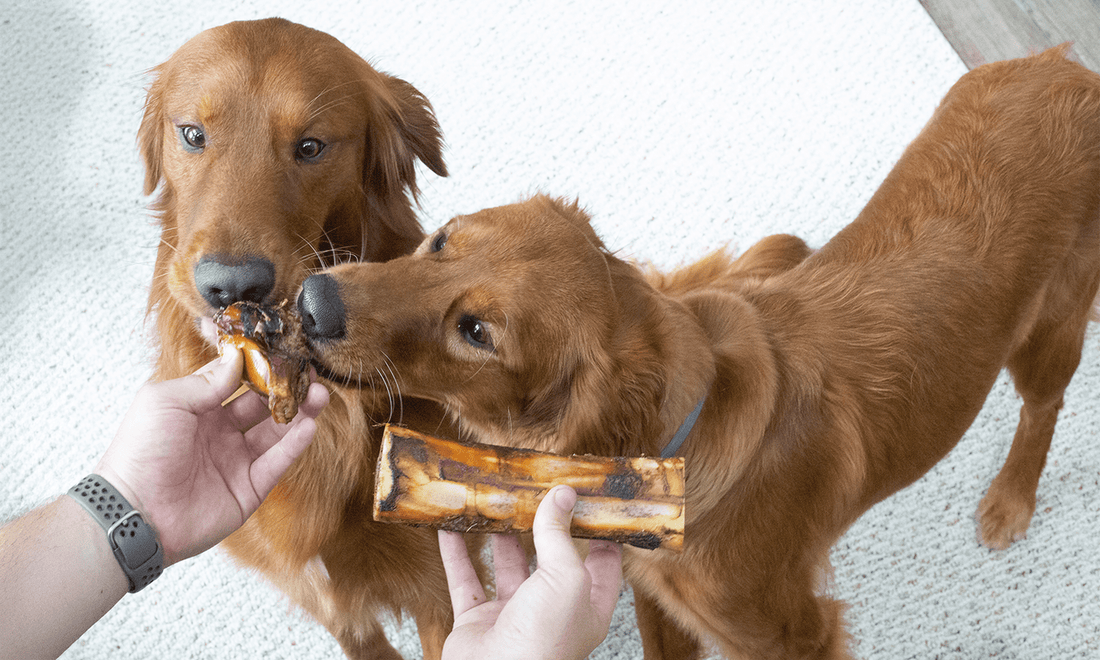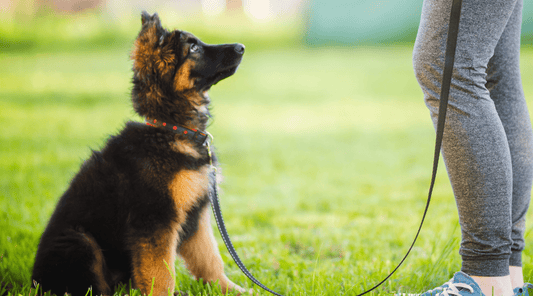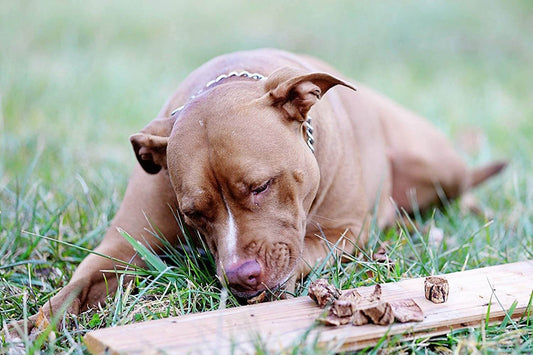
What Type of Bones are Good for Dogs?
Dawn Miller Nov 16, 20245 Minute ReadWhile browsing the dog toy section at our local big box pet store the other day, I noticed the selection of bones lined up down the aisle, each with labels promising durability, chewing time, tastiness, or natural ingredients. It's hard to know what to believe. Which bones are good for dogs...and which ones are just for show?
Are these dog bones free of harmful chemicals, additives, preservatives, and added sugar? Are they nutritious or just for fun? Can they clean my dog's teeth like a toothbrush or help me manage destructive behavior?
It's important to think about why I give my dogs dog bones in the first place. Dog bones are more than a fun diversion and can have serious health benefits when I choose the right type.
My dogs deserve the best dog bones for their health and happiness. And some dog bones are more than just something fun to chew on.
Should Dogs Chew on Bones?
The answer is a resounding yes. Bone gnawing is an instinct domesticated dogs inherited from their ancestral wolves. It provides many benefits, from teeth cleaning to reducing anxiety, and should be a part of a complete dog diet and lifestyle.
Dogs love bones, and it’s no mystery why. Chewing on bones taps into their instincts, offering the satisfaction of a good gnaw while providing mental stimulation. Real bones also have a lot more benefits than synthetic chews or treats.
In fact, those dog parents out there who don't give their fur babies a bone for dogs will often find those dogs acting out—chewing on things they shouldn't, shredding sofa pillows, and barking at every little thing. Dog bones are important for the mental health and sense of well-being that leads to more well-behaved dogs.
I haven't always known about the importance of chew time. And I have lost more than one pair of shoes plus the leg of a walnut dining table in the process.
I give my dogs their bones 2X a week on a schedule. I heard a rumor that dogs and cats could tell time. And with my 3, I know it's true. We're so regular with chew time they expect it as the time arrives. They're sitting in the kitchen patiently, tails wagging as if on cue.
They're not going to let me forget it's chew time ever.
What Type of Bones are Good for Dogs
The best dog bones are natural bones for dogs. The bones have nothing fake in them. They're single ingredient—just a marrow bone. And they come from animals that have strong bones, like cows, sheep, or goats. These bones are filled with nutrition, like B vitamins, healthy fats, collagen, and even glucosamine for healthy joints.
These bones have ample surface area for scraping tarter off teeth, which reduces the harmful bacteria in a dog's mouth by 60-80%.
Because they're real bones, they're not made of plastic, which my dogs would inevitably swallow as they whittle it down to nothing. Especially my aggressive chewer, Bruno. My lab mix can destroy most dog bones in seconds.
They're also not filled with known carcinogens like rawhide bones are. Manufacturers use formaldehyde for tanning and preserving the animal skins after using bleach to make them a uniform color. These bones sort of seem natural. But tanning rawhide is not a natural process. According to The National Canine Cancer Foundation, "prolonged exposure to formaldehyde can elevate the risk of certain cancers."
I think you'll agree; dogs chew on a bone for a "prolonged time."
I prefer grass-fed beef cattle bones. They're the easiest to get sourced from USA ranchers and also have larger bones for big dogs. Most other bones are going to come from overseas.
Dog bones should also be properly prepared for safety. For me, that means using a slow and low-heat cooking process that preserves the nutrition and flavor while killing the pathogens in raw meat.
Now, I've heard from some of you that you're fans of raw dog bones. I personally don't prefer them because, to me, it's like letting my pups drag a raw steak around the house and then lick my face. The American Veterinary Medical Association recommends against raw dog food, believing the risks outweigh the rewards.
Best Types of Chew Bones for Dogs by Size
Beyond the type, it's also important that the bones be the right size. If dog bones are too small, they can cause blockages, which can be fatal. Grass-fed beef cattle have some very big bones. So the Great Dane moms and the Mastiff dads out there can find a massive bone for their oversized, gentle giant.
So, here's a breakdown of the best types of chew bones for each size dog.
Small Dog Chew Bone
For small dogs (under 15lb) and most puppies, Meaty riblets provide a satisfying chew. These are cut from grass-fed beef cattle ribs to be most accessible to little jaws. But if you have a dog that's right on the cusp of small and medium or you have a small and medium dog, then definitely try these Hickory Smoked Knee Caps. They're a little large for small mouths, but because they have crevices, smaller dogs can get their mouth up around them.
It's the perfect in-between, and my terrier Pixie loves them.
Medium-sized Chew Bones for Dogs
For mid-sized dogs like my terrier Pixie, it's hard to beat the Dynamo Bone. These all-natural bones are perfect for dogs over 15lb, and after the marrow is gone, you can refill them with fun treats like peanut butter or pumpkin puree. I have a whole book of dog bone refill recipes for you.
Large Dog Chew Marrow Bones
For big dogs, you really need the most massive bones. And beef cattle deliver. Check out this Goliath Bone. You can't get much bigger than this! Like all of these bones, they are grass-fed, USA-born and raised cattle. It's a single ingredient and can last up to two years in its wrap. It's all flavor plus the nutrition our furry children deserve.
How to Start a Chew Bone Routine
Choose 2-3 days a week when you can supervise chew time. We like Monday and Thursday evenings because weekends can get unpredictable around here. There's so much to do in my dog-friendly neighborhood!
Put it on the calendar. And try to stick with it. To accomplish this, you'll want to make sure you have a good stock of dog bones for your dogs to try. One bone can last for several chew sessions, but I like to have some variety.
Then grab some popcorn or a glass of wine to enjoy while your K9 chomps on their dog bone. After around 15-20 minutes, carefully distract your dog with treats and remove the bone from their sight. Freeze it to preserve it for the next chew session.
Are Natural Bones Worth It?
When you consider all of the added benefits, including avoiding potentially harmful substances, the answer is absolutely yes. Real dog bones from grass-fed cattle do cost a little more. But they also last a long time and have added nutrition. Your dogs and mine deserve the best types of chew bones we can find.
Available On:





